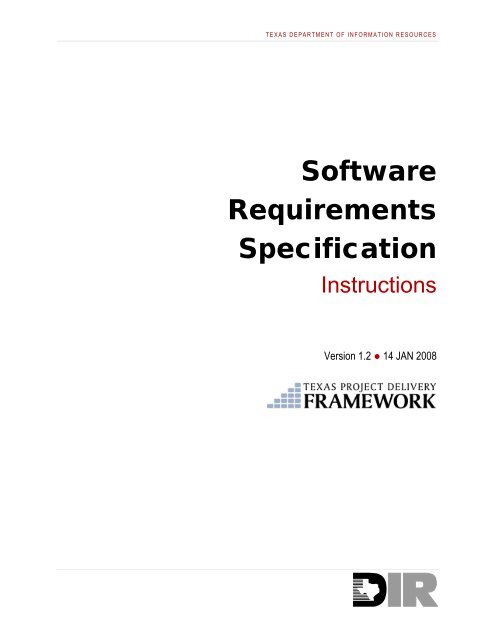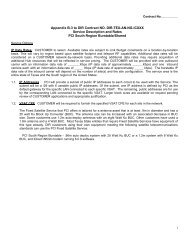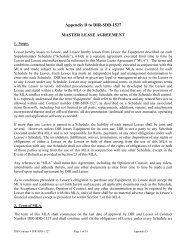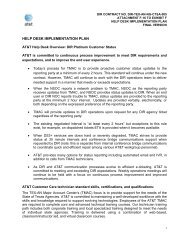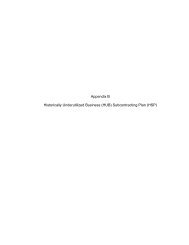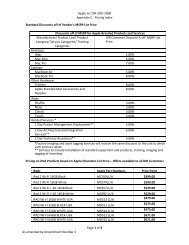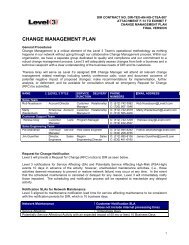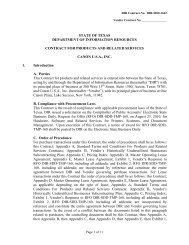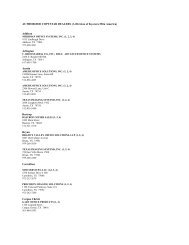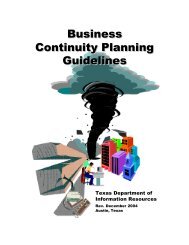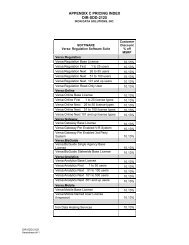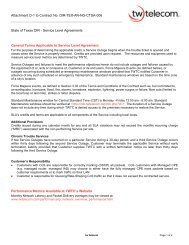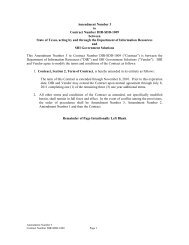Software Requirements Specification - Instructions - Texas ...
Software Requirements Specification - Instructions - Texas ...
Software Requirements Specification - Instructions - Texas ...
Create successful ePaper yourself
Turn your PDF publications into a flip-book with our unique Google optimized e-Paper software.
TEXAS DEPARTMENT OF INFORMATION RESOURCES<strong>Software</strong><strong>Requirements</strong><strong>Specification</strong><strong>Instructions</strong>Version 1.2 ● 14 JAN 2008
<strong>Texas</strong> Project Delivery FrameworkSOFTWARE REQUIREMENTS SPECIFICATION INSTRUCTIONSVersion HistoryThis and other Framework Extension tools are available on the Framework Web site.Release Date14-Jan-200813-Mar-200724-May-2006DescriptionVersion 1.2 released. Modified “Using this Template” section of the Template and italicized allsection instructions to align with the Framework and Change Request (CR) #34. CR #34 wasrecommended by the Framework Change Advisory Board (CAB) and approved by DIR.Version 1.1 released. Made minor modifications to indicate Framework Extension.Version 1.0 <strong>Instructions</strong> and Template Released.DIR Document 25SR-N1-2
<strong>Texas</strong> Project Delivery FrameworkSOFTWARE REQUIREMENTS SPECIFICATION INSTRUCTIONSIntroductionThe <strong>Software</strong> <strong>Requirements</strong> <strong>Specification</strong> (SRS) Template and Template <strong>Instructions</strong> areincluded within the within the System Development Life Cycle (SDLC) Extension of the <strong>Texas</strong>Project Delivery Framework (Framework) to establish a consistent method for documentingsoftware requirements for technology projects. <strong>Software</strong> requirements describe what the softwarewill do, the software’s expected environment, the software’s usage profile, its performanceparameters, and its expected quality and effectiveness. The SRS is a structured collection ofinformation that embodies the requirements of the software. The SRS completely describes allinputs, outputs, and required relationships between inputs and outputs.Documenting software requirements can reduce project risk by reducing uncertainty inimplementation of the software. Documentation of detailed and accurate software requirementscontributes to the success of information technology systems by establishing and communicatingexpectations for all aspects of the software’s features and performance. In addition, thedocumented software requirements provide the basis for ensuring that requirements areaddressed during software design and testing.Use of the <strong>Software</strong> <strong>Requirements</strong> <strong>Specification</strong>Within the Framework, the <strong>Software</strong> <strong>Requirements</strong> <strong>Specification</strong> (SRS) is completed, reviewed,and approved in the Project Planning Review Gate. The SRS documents and communicates thesoftware requirements to the technical community who will specify and build the software. Thecollection of requirements in the SRS must be understandable by stakeholder entities and thetechnical community.Approval of the SRS constitutes agreement that the software satisfying the specifications withinwill be accepted. Once approved, changes can be made to the specifications in the SRS onlythrough the change management process.The <strong>Software</strong> <strong>Requirements</strong> <strong>Specification</strong> Template should be used to develop a SRS for eachproject. The SRS should be developed in coordination with and be accessible by appropriateproject team and stakeholder entities. In addition, all information in the SRS should be consistentwith all project documentation, including the Project Plan and related system development lifecycle documents.NOTE: The <strong>Software</strong> <strong>Requirements</strong> <strong>Specification</strong> should contain descriptive labels for andreferences to every figure, table, and diagram included within the document.DIR Document 25SR-N1-2 Page 1
<strong>Texas</strong> Project Delivery FrameworkSOFTWARE REQUIREMENTS SPECIFICATION INSTRUCTIONSSection 1. OverviewIn the following subsections, provide an overview of the entire <strong>Software</strong> <strong>Requirements</strong><strong>Specification</strong> (SRS). This section should stand alone as an executive summary.1.1 PurposeSpecify the purpose the SRS and its intended audience.1.2 Business ContextProvide an overview of the business organization sponsoring the development of the softwareapplication, including the mission statement and organizational objectives of the business unit.1.3 ScopeDescribe the scope of the software application to be produced. Within the description, include:• The identity of the software product(s)• A brief description of the software’s functionality• An explanation what the software will and will not do• A description of the application of the software• A description of the relevant benefits, objectives, and goals of the softwareThis description should be consistent with similar statements in preceding project documents.1.4 User CharacteristicsIdentify each type of user of the software by function, location, and type of device. Specify thenumber of users in each group and the nature of their use of the software. Characteristics of theusers of the software product will affect the specific requirements. Many people interact withsoftware during the operation and maintenance phases of the software life cycle. Some of thesepeople are users, operators, and maintenance and systems personnel. Certain characteristics ofthese people, such as educational level, experience, and technical expertise may imposeimportant constraints on the software's operating environment.Section 2. Assumptions, Dependencies, Constraints2.1 AssumptionsDescribe each assumption that can affect the requirements specified in the SRS. Assumptionsare factors that are believed to be true during the life cycle of the project that, if changed, mayaffect the project outcomes negatively including, but not limited to, end-user characteristics,known technology infrastructure, resource availability, and funding availability.DIR Document 25SR-N1-2 Page 2
<strong>Texas</strong> Project Delivery FrameworkSOFTWARE REQUIREMENTS SPECIFICATION INSTRUCTIONS2.2 DependenciesDescribe each dependency that can affect the requirements specified in the SRS. Dependenciesare outside of project scope and control and must remain true for the project to succeed. Forexample, a dependency might be that an application relies on a different application to providespecific data or that an interface to a third-party application requires the purchase of anapplication programming interface (API).2.3 ConstraintsProvide a description of the factors that limit the scope and functionality of the software including,but not limited to, regulatory policies, infrastructure limitations, resources, and licensing.Constraints are requirements that are imposed on the solution by circumstance, force, orcompulsion. Constraints limit absolutely the options available to a designer of a solution byimposing immovable boundaries and limits.Section 3. <strong>Requirements</strong>In the following subsections, specify all the requirements to a level of detail sufficient to enabledevelopers to specify and build the software application. Every stated requirement should beunderstandable by users, developers, operators, and external systems staff.Describe at a minimum the transformation of inputs of the software into outputs of the softwareand all functions performed by the software in response to an input or in support of an output.This description may consist of a model of the requirements. For example, the model may containdata flow diagrams, entity relationship diagrams, a Product Network Diagram (PND), and a datadictionary.<strong>Requirements</strong> should be:• Correct, unambiguous, complete, consistent, ranked for importance and/or stability, verifiable,modifiable, and traceable• Cross-referenced to earlier documents that relate• Uniquely identifiable• Organized for maximum readabilityNOTE: Each requirement documented in this section must have a unique identifier forrequirements traceability and should be ranked for importance and/or stability.3.1 Business <strong>Requirements</strong>Describe all requirements from a business perspective. Business requirements are the parts ofthe fully defined business process that will be automated by the software application. Businessrequirements may be defined as use cases.DIR Document 25SR-N1-2 Page 3
<strong>Texas</strong> Project Delivery FrameworkSOFTWARE REQUIREMENTS SPECIFICATION INSTRUCTIONS3.2 Functional <strong>Requirements</strong>Customize this subsection to contain the subsections necessary to comprehensively define thefundamental actions that must take place within the software to accept and process the inputsand to process and generate the outputs.Fundamental actions in functional requirements include:• Validity checks on the inputs• Exact sequence of operations• Responses to abnormal situations, including overflow and communication facilities• Effect of parameters• Relationship of outputs to inputs, including• Input/output sequences• Formulas for input to output conversion• Definitions of the responses of the software to all realizable classes of input data in allrealizable classes of situationsFunctional requirements should include specific requirements for business rules. Business rulesdescribe and document the steps in a business process.It may be appropriate to partition the functional requirements into subfunctions or sub processes.This does not imply that the architecture or software design will also be partitioned in that way.The two common means of specifying functional requirements are functional decomposition anduse cases.Subsection templates for each of the means of specifying functional requirements are providedbelow.3.2.XF Function XWhen functional decomposition is used as the means of specifying the functional requirementsprovide a 3.2.xf subsection for each function. Each 3.2.xf subsection should be labeled and titledappropriately for a specific function, where xf is the appropriate sequential subsection numberand X is the name of the specific function.3.2.XF.1 Function X PurposeDescribe the intent of the function.3.2.XF.2 Function X InputsDescribe the inputs to the function, including sources, valid ranges of values, timingconsiderations, operator requirements, and special interfaces.DIR Document 25SR-N1-2 Page 4
<strong>Texas</strong> Project Delivery FrameworkSOFTWARE REQUIREMENTS SPECIFICATION INSTRUCTIONS3.2.XF.3 Function X OperationsDescribe the operations to be performed within the function, including validity checks,responses to abnormal conditions, and types of processing required.3.2.XF.4 Function X OutputsDescribe the outputs from the function, including output destinations, valid ranges of values,timing considerations, and considerations for handling of illegal values, error messages, andinterfaces required.3.2.XU Use Case YWhen use cases are used as the means of specifying the functional requirements provide a3.2.xu subsection for each use case. Each 3.2.xu subsection should be labeled and titledappropriately for a specific use case, where xu is the appropriate sequential subsection numberand Y is the name of the specific use case.Within each use case subsection, specify the use case information, including the actor, preconditions,post-conditions, scenarios, and alternate scenarios.3.3 Logical Data <strong>Requirements</strong>Describe all logical data requirements for the software. Logical data requirements may include:• Types of information used by various functions• Frequency of use• Accessing capabilities• Data entities and their relationships• Integrity constraints• Data retention requirements3.4 User <strong>Requirements</strong>Describe user requirements for the software application. User requirements capture the intendedbehavior of the human interface for the application. For example, if the user operates through adisplay terminal, specify the required screen content, content of any reports or menus, andrelative timing of inputs and outputs. User requirements may include example screen or reportformats as prototypes to illustrate requirements.3.5 Information Management <strong>Requirements</strong>Specify requirements for managing the creation, capture, organization, maintenance, use,protection, and disposition of information in accordance with applicable laws, regulations, policies,and standards.DIR Document 25SR-N1-2 Page 5
<strong>Texas</strong> Project Delivery FrameworkSOFTWARE REQUIREMENTS SPECIFICATION INSTRUCTIONS3.6 Systems <strong>Requirements</strong>3.6.1 Performance <strong>Requirements</strong>Describe the performance conditions and their associated capabilities. Include suchconsiderations as:• Dynamic actions or changes that occur (e.g., rates, velocities, movements, and noise levels)• Quantitative criteria covering endurance capabilities of the equipment required to meet theuser needs under stipulated environmental and other conditions, including minimum total lifeexpectancy. Indicate required operational session duration and planned utilization rate.• Performance requirements for the operational phases and modes• The number of terminals to be supported• The number of simultaneous users to be supported• The numbers of transactions and tasks and the amount of data to be processed within certaintime periods for both normal and peak workload conditions• Acceptable performance under atypical stressState these requirements in measurable terms. For example, 95 percent of the transactions shallbe processed in less than one second, rather than, operator shall not have to wait for thetransaction to complete.Performance characteristics unique to a specific function (see Functional <strong>Requirements</strong>subsection) and outside the general performance characteristics of the software should bespecified as part of the processing description of that function.3.6.2 Quality <strong>Requirements</strong>Describe requirements for the quality characteristics of the software. Specify the requirements inmeasurable and verifiable terms. Describe any trade-offs between the characteristics (e.g.,security versus portability). Definitions of the quality characteristics include:• Correctness – extent to which program satisfies specifications and fulfills user’s missionobjectives• Efficiency – amount of computing resources and code required to perform function• Flexibility – effort needed to modify operational program• Integrity/Security – extent to which access to software or data by unauthorized people can becontrolled. Security requirements relate to both the facility that houses the system andoperational security requirements. Examples of security requirements might be to specify thesecurity and privacy requirements, including access limitations to the software, such asexistence of log-on procedures and passwords, and of data protection and recovery methods.This could include the factors that would protect the software from accidental or maliciousaccess, use, modification, destruction, or disclosure.DIR Document 25SR-N1-2 Page 6
<strong>Texas</strong> Project Delivery FrameworkSOFTWARE REQUIREMENTS SPECIFICATION INSTRUCTIONSSection 4. <strong>Requirements</strong> Traceability MatrixIn this section, provide reference to the location of the <strong>Requirements</strong> Traceability Matrix (RTM)that indicates traceabilty from the system requirements documented in the System <strong>Requirements</strong><strong>Specification</strong> (SyRS) to the design elements documented in the System Design Description(SyDD) to the software requirements documented in the <strong>Software</strong> <strong>Requirements</strong> <strong>Specification</strong>(SRS).The RTM is initiated in the SyRS and is updated appropriately during the life of the project toindicate traceabilty to the design elements documented in the SyDD, the software requirementsdocumented in the SRS, and the design elements documented in the SDD. The completed RTMassures that every requirement has been addressed in the design and that every design elementaddresses a requirement. The RTM also provides the necessary traceability for integration,acceptance, regression, and performance testing.The <strong>Requirements</strong> Traceability Matrix in the SRS should:• Contain the columns used to illustrate traceability of the system requirements to the systemdesign elements, software requirements, and software design elements• Contain the columns necessary to illustrate traceability for integration, acceptance,regression, and performance testing• Be populated with all requirements documented in the SyRS• Be populated with all design elements documented in the SyDD• Be populated with all requirements documented in the SRS• Indicate traceabilty from the system requirements documented in the SyRS to the designelements documented in the SyDD• Indicate traceability from design elements documented in the SyDD to the softwarerequirements documented in the SRS• Indicate the source or origin of each requirementA sample RTM template is provided as an additional tool in the Appendix of the System<strong>Requirements</strong> <strong>Specification</strong> Template <strong>Instructions</strong>.Section 5. ReferencesIdentify the information sources referenced in the <strong>Software</strong> <strong>Requirements</strong> <strong>Specification</strong> andutilized in developing the <strong>Software</strong> <strong>Requirements</strong> <strong>Specification</strong>. Include for each the documentnumber, title, date, and author.DIR Document 25SR-N1-2 Page 8
<strong>Texas</strong> Project Delivery FrameworkSOFTWARE REQUIREMENTS SPECIFICATION INSTRUCTIONSSection 6: GlossaryDefine of all terms and acronyms required to interpret the <strong>Software</strong> <strong>Requirements</strong> <strong>Specification</strong>properly.Section 7: Revision HistoryIdentify changes to the <strong>Software</strong> <strong>Requirements</strong> <strong>Specification</strong>.Section 8: AppendicesInclude any relevant appendices.DIR Document 25SR-N1-2 Page 9


